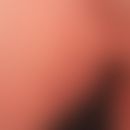Synonym(s)
DefinitionThis section has been translated automatically.
Rare folliculitis caused by Candida species, especially in the beard area, mostly in diabetes mellitus and weakened immune system (malignant lymphomas, leukemias, HIV/AIDS, often preceding long-term therapy with glucocorticosteroids or cytostatics.
PathogenThis section has been translated automatically.
You might also be interested in
EtiopathogenesisThis section has been translated automatically.
Predisposing factors that cause a general or local disturbance of the immune system are: diabetes mellitus, lymphomas, HIV/AIDS, leukemias, immunosuppressive and cytostatic therapy, long-term local therapy with glucocorticosteroids.
ManifestationThis section has been translated automatically.
LocalizationThis section has been translated automatically.
ClinicThis section has been translated automatically.
DiagnosisThis section has been translated automatically.
Pathogen detection (native and cultural) from crusts and from depilated whiskers.
Differential diagnosisThis section has been translated automatically.
Impetigo contagiosa: lack of mycological evidence of Candida species
Tinea barbae: mostly extensive infestation; detection of dermatophytes
Folliculitis simplex barbae: lack of mycological evidence of Candida species
acne pustulosa: general acne disposition, seborrhoea
Eoosinophilic pustulose (infantile form): very itchy, follicular vesicles and pustules of 0.2-0.3 cm in diameter observed Bluteosinophilia!
Pustular psoriasis variants: rarely in the facial area
Complication(s)(associated diseasesThis section has been translated automatically.
General therapyThis section has been translated automatically.
External therapyThis section has been translated automatically.
Remove the crusts with 2-5% salicylic acid ointment(e.g. Salicylvaseline Lichtenstein, R228 ) or oil or moist dressings. In the short term, moist compresses with antiseptic additives such as quinolinol (e.g. quinosol 1:1000, R042 ) or dilute potassium permanganate solution(light pink) may also be used. Later, broad-spectrum antifungal agents of the azole type such as 2% clotrimazole creams / ointments(e.g. R056, Canesten cream) or Ciclopirox (e.g. Batrafen cream).
Internal therapyThis section has been translated automatically.
LiteratureThis section has been translated automatically.
- Seebacher C et al (2006) Candidosis of the skin. J Dtsch Dermatol Ges 4: 591-596
Incoming links (10)
Beard fungus lichen; Candidafolliculitis; Clotrimazole ointment hydrophilic 2% (nrf 11.50.); Folliculitis eczematosa barbae; Folliculitis gramnegative; Folliculitis superficial; Quinolinol sulphate monohydrate solution 0,1 % (nrf 11.127.); Salicylic acid oil 2/5 or 10% (nrf 11.44.); Salicylic acid ointment 1/2/3/5/10 or 20% (nrf 11.43.); Tinea barbae;Outgoing links (26)
Acne papulopustulosa; Antimycotics; Antiseptic; Candida; Candidiasis of the oral mucosa; Candidoses; Candidosis, enteral; Ciclopirox; Clotrimazole; Clotrimazole ointment hydrophilic 2% (nrf 11.50.); ... Show allDisclaimer
Please ask your physician for a reliable diagnosis. This website is only meant as a reference.




